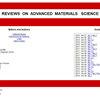Discrete element simulation study on effects of grain preferred orientation on micro-cracking and macro-mechanical behavior of crystalline rocks
IF 3.6
4区 材料科学
Q2 MATERIALS SCIENCE, MULTIDISCIPLINARY
引用次数: 0
Abstract
Grain-preferred orientation significantly influences the brittle fracture mechanism and failure mode of crystalline rocks. However, current grain-based models (GBMs) based on particle flow code (PFC) software are mostly proposed on the basis of the Voronoi tessellation method for grain boundary generation, which is difficult to simulate the heterogeneity of microstructure such as shape and orientation of rock minerals. To study the effect of grain-preferred orientation on macroscopic mechanical properties and microscopic characteristics of crystalline rocks, a novel grain-based microstructure transformation method (MTM) is proposed. Based on the MTM, a GBM with a target aspect ratio and crystal orientation is obtained by transforming the Voronoi crystal geometry through a planar coordinate mapping. Specifically, embedded FISH language is used to control random mineral seed size and distribution pattern to generate Tyson polygons. A polygon geometry that satisfies the rock texture is obtained as a grain boundary by spatially transforming the vertex of the Tyson polygon. The transformed complex geometry is taken as the crystal structure of the GBM, and the Lac du Bonnet granite models with different aspect ratios and crystal orientations were developed in PFC晶粒优选取向对结晶岩微裂纹和宏观力学行为影响的离散元模拟研究
晶粒优选取向对晶质岩石的脆性断裂机理和破坏模式有重要影响。然而,目前基于粒子流代码(PFC)软件的晶粒模型(GBM)大多是基于Voronoi细分法生成晶界而提出的,难以模拟岩石矿物的形状和取向等微观结构的异质性。为了研究晶粒优选取向对结晶岩石宏观力学性能和微观特征的影响,提出了一种新颖的基于晶粒的微结构转换方法(MTM)。在 MTM 的基础上,通过平面坐标映射转换 Voronoi 晶体几何图形,得到具有目标长宽比和晶体取向的 GBM。具体来说,嵌入式 FISH 语言用于控制随机矿物种子大小和分布模式,以生成泰森多边形。通过对泰森多边形的顶点进行空间变换,得到满足岩石纹理的多边形几何图形作为晶粒边界。将变换后的复杂几何体作为 GBM 的晶体结构,并在 PFC2D 中开发了具有不同长宽比和晶体取向的 Lac du Bonnet 花岗岩模型。最后,在 PFC2D 中进行了一系列无压抗压强度测试,以验证所提出的晶体几何变化建模方法,并从不同角度研究晶粒优选取向对结晶岩宏观力学性能和微观断裂机制的影响。
本文章由计算机程序翻译,如有差异,请以英文原文为准。
求助全文
约1分钟内获得全文
求助全文
来源期刊

Reviews on Advanced Materials Science
工程技术-材料科学:综合
CiteScore
5.10
自引率
11.10%
发文量
43
审稿时长
3.5 months
期刊介绍:
Reviews on Advanced Materials Science is a fully peer-reviewed, open access, electronic journal that publishes significant, original and relevant works in the area of theoretical and experimental studies of advanced materials. The journal provides the readers with free, instant, and permanent access to all content worldwide; and the authors with extensive promotion of published articles, long-time preservation, language-correction services, no space constraints and immediate publication.
Reviews on Advanced Materials Science is listed inter alia by Clarivate Analytics (formerly Thomson Reuters) - Current Contents/Physical, Chemical, and Earth Sciences (CC/PC&ES), JCR and SCIE. Our standard policy requires each paper to be reviewed by at least two Referees and the peer-review process is single-blind.
 求助内容:
求助内容: 应助结果提醒方式:
应助结果提醒方式:


